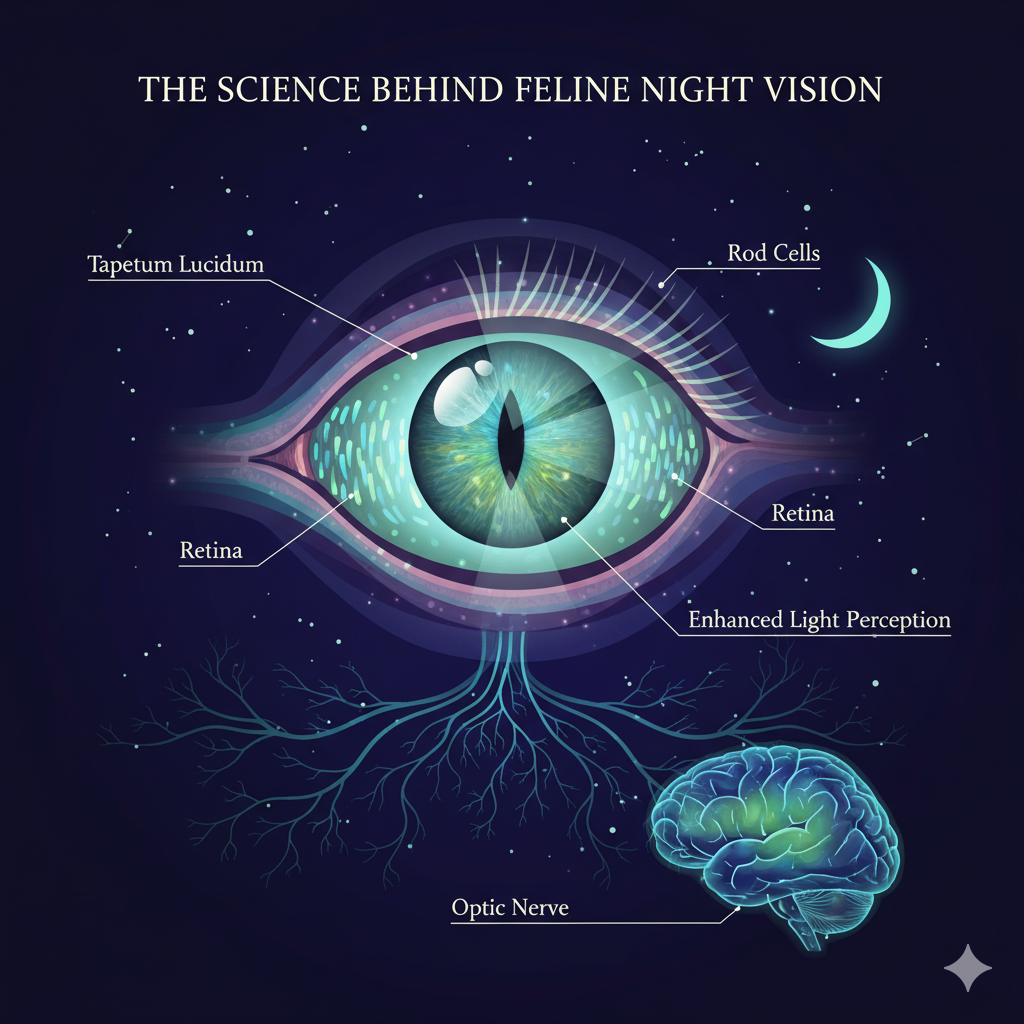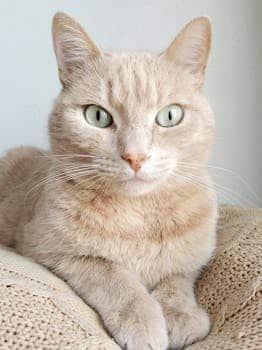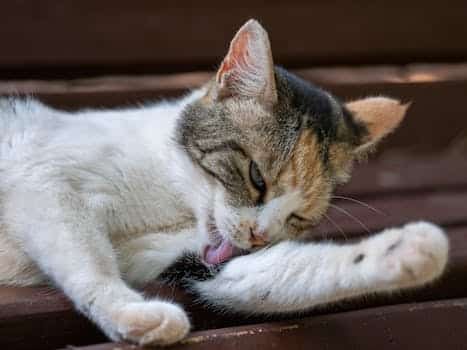Post Disclaimer
Catopedea shares information for educational and general interest purposes only. Our content is not a substitute for professional veterinary advice, diagnosis, or treatment. Always consult a licensed veterinarian for concerns about your cat’s health, diet, or behavior.
Cats are fascinating creatures, especially when it comes to their vision. Many people wonder if cats can see in the dark. The answer is both simple and complex.
Cats have evolved to see well in low light. This ability is due to several unique features of their eyes.
However, they cannot see in complete darkness. They need some light to navigate their surroundings.
Understanding how cats see in the dark can help pet owners better care for their feline friends.
In this article, we will explore the science behind cats’ night vision. We’ll also debunk some common myths about their eyesight.
How Well Can Cats See in the Dark?
Cats are remarkable at seeing in low light conditions. Their night vision is much better than humans’. This is partly due to their ability to use minimal light effectively. In the dark, cats see using numerous rod cells in their retinas. These cells improve their ability to see when light levels are low. Compared to humans, cats need just one-sixth the light to see.
This exceptional vision makes them incredible nocturnal hunters. Cats can detect motion easily, which is vital for spotting prey at night.
Here’s why cats excel in low light:
- Abundant rod cells for low-light vision
- The tapetum lucidum reflects light back through the retina
- Slit-shaped pupils open wide to capture more light
While cats can’t see perfectly in total darkness, they’re well-adapted to semi-dark environments. Their eyes shine brightly due to the tapetum lucidum’s reflective properties.
The Science Behind Feline Night Vision

Cats possess an extraordinary night vision system fueled by fascinating science. This system hinges on several unique anatomical features of their eyes. These adaptations grant them superior low-light visibility.
A key element contributing to their night vision is the tapetum lucidum. This reflective layer, positioned behind the retina, enhances their sight. It bounces light back through the retina, maximizing available light even in dim conditions.
Furthermore, cats have large pupils that can dilate substantially. This allows their eyes to soak up as much ambient light as possible. Their pupils can open three times wider than humans’ pupils.
Some remarkable features of feline night vision include:
- Reflective tapetum lucidum
- Highly sensitive rod cells
- Wide, dilating pupils
Cats’ retinas are rich in rod cells, which are sensitive to low light but can’t detect color. These are the crucial components allowing cats to see when other animals struggle.
The combination of these features makes cats formidable hunters at night. Their eyes adjust quickly to changing light, keeping them ready for any situation.
Key Features of a Cat’s Eye
Cats have fascinating eyes designed for low-light environments. These unique features set them apart from other animals.
One distinctive aspect is their slit-shaped pupils. These pupils can expand significantly to absorb more light in dark settings. This adaptation is crucial for their hunting lifestyle.
Additionally, cats have a wide field of view. Their eyes offer around 200 degrees of visibility. This helps them notice movements and potential prey around them.
Cats’ eyes are also structured to enhance sensitivity. The large cornea and lens allow more light to enter. This design aids their impressive night vision capabilities.
Some key features of a cat’s eye include:
- Slit-shaped pupils
- Wide field of view
- Large cornea and lens
The combination of these features ensures cats remain agile and alert in the dark. Their eyes are perfectly suited for their crepuscular activity, showcasing evolution’s ingenious designs.
by Joan Li (https://unsplash.com/@_bubble_maker)
Can Cats See in Complete Darkness?
Cats are often associated with seeing in complete darkness. However, this is a common misconception. Even cats need some light to see.
Cats thrive in lowlight conditions rather than total darkness. Their eyes capture and enhance any available light. This ability is thanks to a unique eye structure.
In pitchblack settings, cats rely on other senses. They use their acute hearing and smell to navigate. This multisensory approach helps them move confidently, even when their vision is challenged.
How Cats’ Vision Compares to Humans
Cats’ vision differs from humans in many ways. They have several advantages in low light but see less detail. Their eye structure is adapted for dusk and dawn.
Key Differences in Vision:
- Wider field of view: Cats enjoy about 200 degrees, compared to humans’ 180 degrees.
- Better motion detection: Cats can spot tiny movements due to rod-rich retinas.
- Color perception: Cats see fewer colors, focusing on blues and greens.
In bright light, human vision is sharper than a cat’s. Cats prioritize movement and low-light capabilities instead of vivid colors or fine detail. This gives them an edge during night activities.
Other Senses Cats Use in the Dark
Cats have more than just keen eyes to navigate dark areas. They rely heavily on other senses, which help them hunt and move. These senses are crucial for their nighttime adventures.
Key Senses Enhancing Night Vision:
- Hearing: Cats can detect a wide range of sounds.
- Smell: Cats have an excellent sense of smell.
- Whiskers: Their whiskers sense nearby objects and movements.
Together, these abilities make cats excellent nocturnal predators. Their non-visual senses provide essential information, helping them thrive in low-light environments.
Myths and Facts About Cats’ Night Vision
Many believe cats can see in complete darkness. This is a myth. Cats require some light, no matter how dim, to see.
Common Misconceptions and Truths:
- Myth: Cats see in total darkness.
- Fact: Cats need minimal light to see.
- Myth: Cats’ vision is perfect at night.
- Fact: Cats detect movement better than detail at night.
Understanding these distinctions helps appreciate the true capabilities of feline night vision.
Tips for Supporting Your Cat’s Nighttime Needs
Ensuring your cat feels comfortable at night is crucial. Cats benefit from environments that cater to their crepuscular nature.
Consider the following tips to enhance their nighttime experience:
- Provide cozy sleeping areas.
- Ensure quiet spaces during twilight hours.
- Supply easily accessible food and water.
By meeting these needs, you support their natural instincts. This can lead to a more content and active cat.
When to Worry About Your Cat’s Eyesight
Cats rely heavily on their vision for daily activities. Notice changes in behavior or signs of distress in your cat’s vision.
You should observe for:
- Squinting or rubbing eyes.
- Cloudy or inflamed eyes.
- Changes in eye color or shape.
These symptoms might indicate issues needing veterinary attention. Early detection is key to maintaining their eye health. Regular checkups can also prevent long-term problems.
FAQs About Cats’ Night Vision
Can cats really see in the dark?
Cats can’t see in complete darkness, but they’re excellent at seeing in very low light. Their eyes use special features like rod cells and the tapetum lucidum to amplify any available light.
Do cats have better night vision than humans?
Yes. Cats need only about one-sixth of the light humans do to see. Their eyes are built to detect movement in dim light, while humans rely more on sharp detail and color in brighter conditions.
Do cats have better night vision than dogs?
Both cats and dogs see well in low light, but cats generally have an advantage. Their eyes contain more rod cells and a more efficient tapetum lucidum, giving them stronger night vision compared to dogs.
Can cats see color at night?
Cats see fewer colors than humans, mostly shades of blue and green. At night, their vision relies heavily on rod cells, which are great for low light but poor at detecting color.
Why do my cat’s eyes glow in the dark?
That glow comes from the tapetum lucidum, a reflective layer behind the retina. It bounces light back through the eye, boosting vision in dim settings and creating the glowing effect.
How can I help my cat at night?
Provide cozy sleeping spots, keep food and water accessible, and ensure safe spaces for play. Cats also benefit from dim nightlights, which make moving around easier.
Conclusion
Cats may seem like they have supernatural night vision, but the truth is more practical. They can’t see in complete darkness, yet their eyes are specially designed to excel in low-light conditions. Features like rod-rich retinas, wide pupils, and the reflective tapetum lucidum give them a huge advantage over humans when it comes to dusk and dawn activity.
While they still need a little light to navigate, their sharp motion detection and reliance on other senses – like hearing, smell, and whiskers – make them excellent nighttime explorers. Understanding how your cat sees the world helps you appreciate not only their hunting instincts but also the incredible adaptations that make them so unique.
If you’re curious about more feline quirks, check out our guide on odd cat behaviors and what they really mean. It’s a fun way to dive deeper into the mysterious world of cats.


